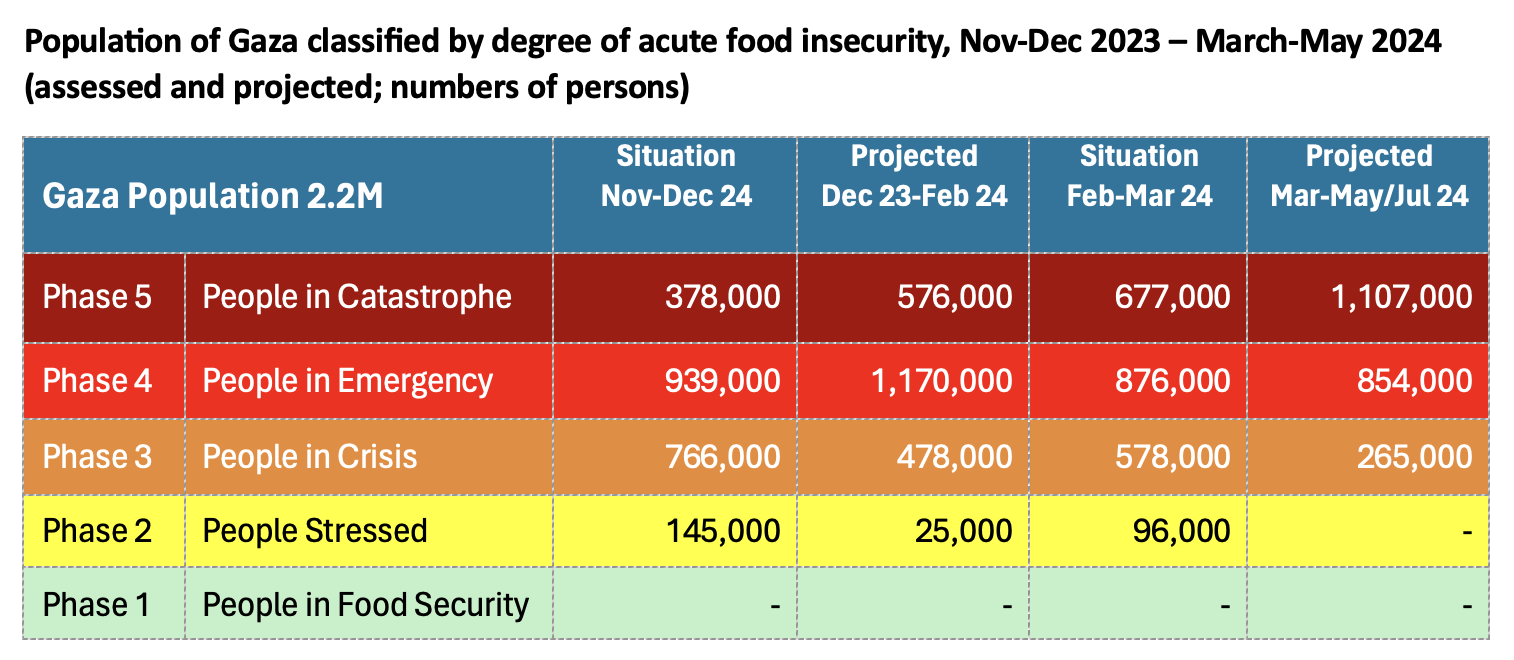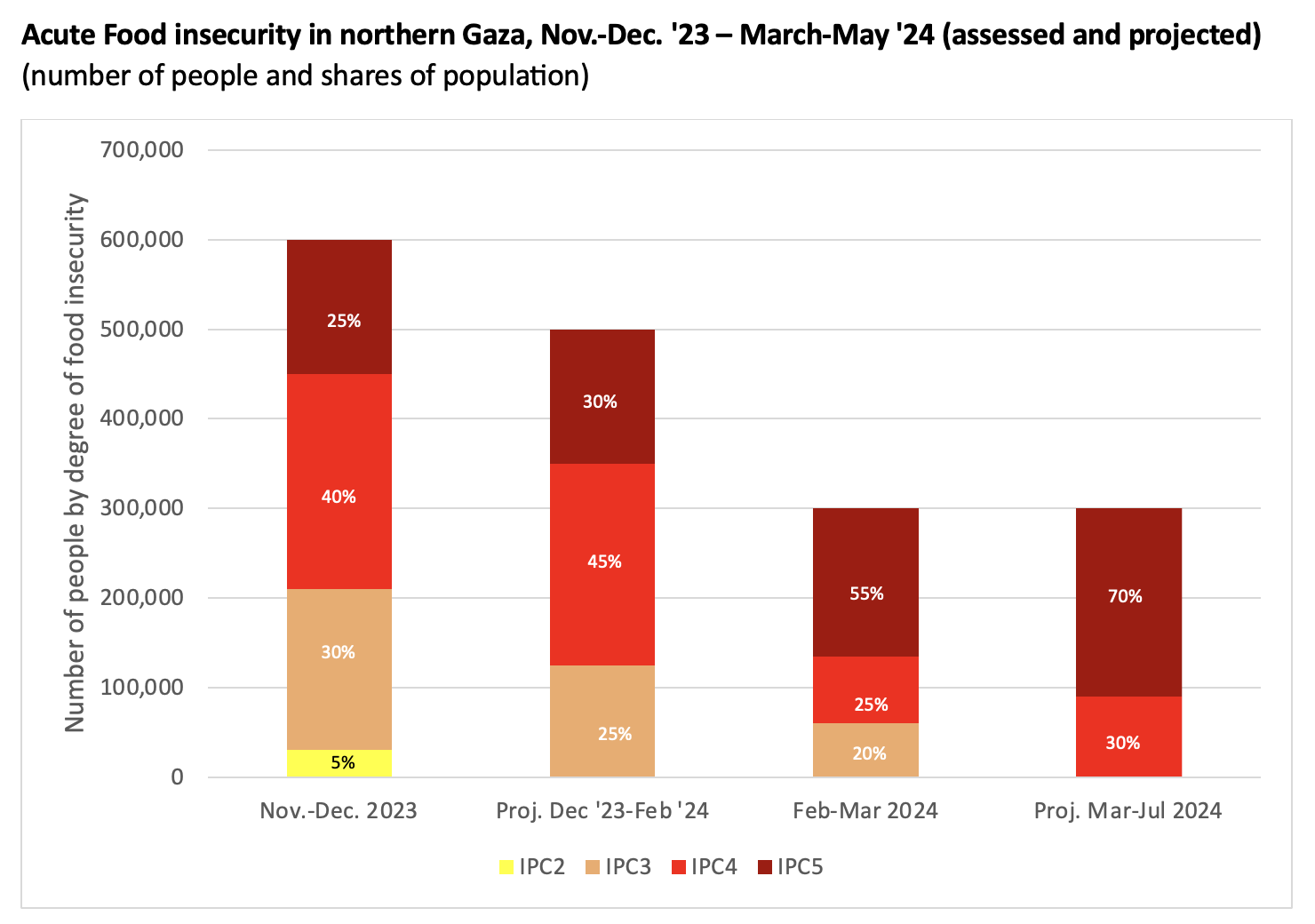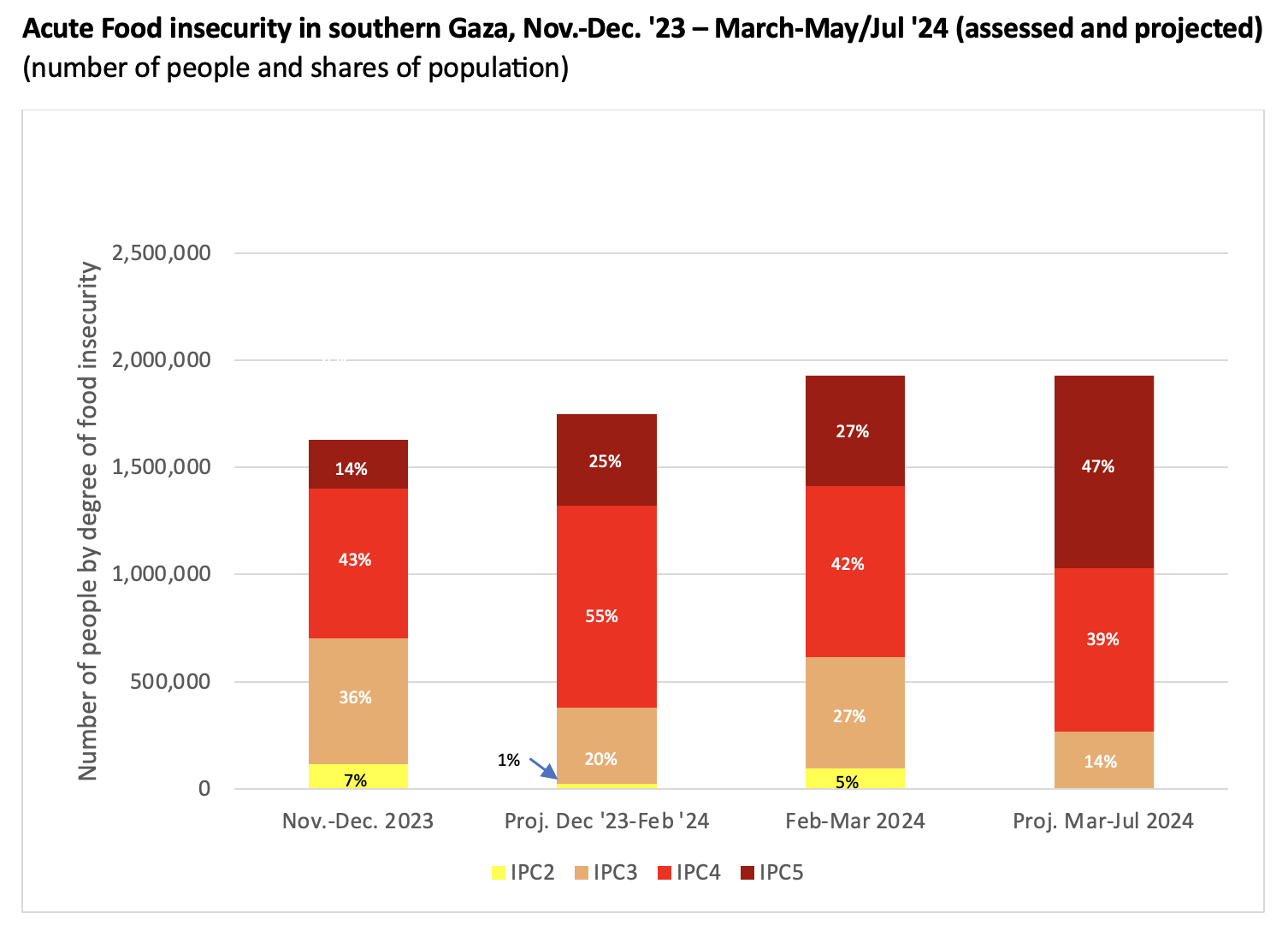Is it too late to save Gaza’s population from famine? The latest assessment of the Integrated Food Security Phase Classification (IPC) global partnership suggests this is imminent for at least half the population of 2.2 million.
The assessment estimates that 685,000 people faced “catastrophic” levels of acute food insecurity or famine-like conditions as of early March—a clear deterioration from a previous assessment in December 2023. In a highly likely scenario of continued conflict escalation, 1.1 million people in Gaza face famine and the risk of dying from hunger in the coming weeks or months (Table 1).
Table 1
Source: IPC Global Partners
IPC’s Famine Review Committee has validated this assessment and states that famine can only be averted or alleviated by an immediate cessation of hostilities and granting of full access to humanitarian agencies to provide water, food, and medical supplies and to restore basic services for health, drinking water supplies, and sanitation and energy for the entire population in the Gaza Strip.
With no ceasefire in sight in the Israel-Hamas war and continued constraints on humanitarian assistance flowing into Gaza, prospects for averting one of the largest famines in recent history seem very grim. Worse, Israeli attacks on Gaza have hit warehouses with food for humanitarian assistance and killed people waiting for such assistance.
IPC sees famine as “imminent” in the northern governorates, Gaza and North Gaza, which have been most heavily affected by the hostilities, leading to the devastating destruction of homes, infrastructure, and basic services, as well as severe damage of agricultural lands and livelihoods.
At least half of the population in northern Gaza has been forcibly displaced, IPC estimates, seeking refuge in southern governorates. By early March, an estimated 55% or 165,000 of the remaining population in northern Gaza were in IPC Phase 5 (IPC5, Catastrophe) and this share is projected to increase to 70% (210,000 people) if residents cannot get immediate access to adequate humanitarian assistance (Figure 1). IPC estimates further that all of Gaza’s population in the northern areas is in either catastrophic (IPC5) or emergency (IPC4) levels of acute food insecurity. Virtually all households in North Gaza are skipping meals every day and adults are reducing their own food intake so that children can eat. Nonetheless, at least one in every six children is acutely malnourished, their numbers are rising rapidly, and available evidence also points towards a steep rise in child deaths, leading IPC to signal the imminent onset of famine in northern Gaza.
Figure 1
Source: IPC Global Partners
The situation is also rapidly worsening in the southern governorates of Khan Younis, Deir al-Balah, and Rafah, where currently more than 85% of the population of Gaza is concentrated. In early March, 27% were classified as facing famine-like conditions (IPC5), up from 14% in early December 2023 (Figure 2). This is likely to rise to near 50% (or over 900,000 people) in the coming weeks or months, IPC projects. In Khan Younis and Deir al-Balah. this share is projected to surpass 50%, while in Rafah it would affect 45% of the population.
Figure 2
Source: IPC Global Partners
IPC thus concludes there is also a high risk that famine will affect all southern governorates in the period from mid-March to mid-July 2024. This risk is projected under high probability scenario that assumes further escalation of the conflict in the South, including in Rafah and a continuation of the military offensive in Khan Younis, as well as continued severe limitations on distributions of humanitarian aid. Such conditions would further spur displacements from Rafah to the al-Mawasi area, a narrow strip on the southern coast of Gaza.
Deteriorating public health conditions are a related problem. The scenario does not account for the possible outbreak of infectious disease epidemics. However, the risk of outbreaks of cholera and other infectious diseases is increasing as sanitary conditions worsen. Combating any such epidemic will be nearly impossible without restoration of health and other basic services, and without an end to the hostilities.
Finally, the dire food insecurity situation is also driving up child undernourishment, a product not just of inadequate food quantities but also increasing micronutrient deficiency—a dangerous problem that can have long-term impacts on health and development. The damage to domestic food production has severely reduced availability of fruits and vegetables, key sources of micronutrients. The food rations of aid agencies (often mostly flour and vegetable oil) do not compensate for this shortfall. It is therefore critical to enable humanitarian agencies to provide balanced nutrient-adequate food rations. Once security conditions allow, cash transfers, restoration of market infrastructure and of damaged agricultural land will help market-based access to food recover and renew livelihood opportunities.
This may be the last possible clarion call to all parties to take steps to avert this imminent massive human catastrophe. As IPC concludes, it is hard to see any way to slow the rapid descent into disaster without an immediate cease-fire and a way to bring provisions of food, water, energy, medicines, and sanitation and hygiene supplies to levels of minimum adequacy. Immediate unconstrained opening of land crossings for humanitarian assistance will be essential, as recent efforts of bringing in supplies over sea and through air drops are either too slow or ineffective.
Getting out of the present food crisis and averting an imminent human disaster will not be easy, but it is still possible. But it is only possible if hostilities are ended immediately and enhanced humanitarian assistance can enter Gaza unconstrained—and as soon as possible.
Rob Vos is Director of IFPRI’s Markets, Trade, and Institutions (MTI) Unit; Ismahane Elouafi is the Executive Managing Director of CGIAR; Johan Swinnen is Managing Director, Systems Transformation, CGIAR, and IFPRI Director General. Opinions are the authors’.







